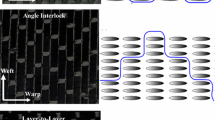Abstract
Liquid moulding processes are unique in that resin is infused into a dry fibre preform. Appropriate wet-out of the reinforcing fibres is thus a necessity for the achievement of good composite properties. For this class of manufacturing methods, both macroscopic flow, as related to Darcy's Law and characterized by permeability, and microscopic flow, as related to fibre wet-out, are important. The current research investigates factors affecting permeability and fibre wet-out as related to liquid moulding. Specifically, it is shown that fabric permeability is dependent on the type of test fluid used. Surface tension and contact angle measurements indicate that interactions at the microscopic level between fibre and test fluid account for these differences in permeability. The investigation illustrates the competing nature of macroscopic and microscopic flow in liquid moulding.
Similar content being viewed by others
References
M. H. Naitove,Plast. Technol. 28 (1982) 79.
I. Sayama, I. Nomura, K. Tabei andS. Gotoh, in Proceedings of the Society of the Plastics Industry/Reinforced Plastics-Composites Institute 36th Annual Technical Conference, Cincinnati, OH (1981) p. 1.
C. F. Johnson, N. G. Chavka, R. A. Jeryan, C. J. Morris andD. A. Babbington, in Proceedings of the Third Annual ASM/BSD Advanced Composites Conference, Detroit, MI (ASM International, Metals Park, Ohio, USA, 1987) p. 197.
C. F. Griffith, W. E. Harvill, R. R. Johnson andR. E. Bohlmann,Aerospace America 26 (1988) 28.
R. S. Parnas andF. R. Phelan, Jr.,SAMPE Quart. 22 (1991) 53.
S. Wu, “Polymer interface and adhesion” (Marcel Dekker, Inc., New York, 1982).
J. P. Coulter andS. I. Güçéri,J. Reinf. Plast. Compos. 7 (1988) 200.
M. V. Bruschke andS. G. Advani,Polym. Compos. 11 (1990) 398.
P. C. Carman,Trans. Inst. Chem. Eng. 15 (1937) 150.
R. J. Marshall andA. B. Metzner,Ind. Engng Chem. Fund. 6 (1967) 393.
Z. Kemblowski andM. Michniewicz,Rheol. Acta 18 (1979) 730.
E. M. Sparrow andA. L. Loeffler,AIChe J. 5 (1959) 325.
A. S. Sangani andA. Acrivos,Int. J. Multiphase Flow 8 (1982) 193.
R. E. Larson andJ. L. L. Higdon,J. Fluid Mech. 166 (1986) 449.
J. G. Williams, C. E. M. Morris andB. C. Ennis,Polym. Engng Sci. 14 (1974) 413.
A. S. Sangani andC. Yao,Phys. Fluids 31 (1988) 2435.
G. Q. Martin andJ. S. Son, in Proceedings of the Second Annual ASM/ESD Advanced Composites Conference, Detroit, MI (ASM International, Metals Park, Ohio, USA, 1986) p. 149.
R. Gauvin andM. Chibani,SAMPE Quart. 21 (1990) 52.
Y. R. Kim, S. P. McCarthy, J. P. Fanucci, S. C. Noet andC. Koppernaes,ibid. 22 (1991) 16.
S. J. Claus andA. C. Loos, in Proceedings of the American Society for Composites Fourth Annual Technical Conference, Blacksburg, Virginia (1989) p. 147.
L. Trevino, K. Rupel, W. B. Young, M. L. Liou andL. J. Lee,Polym. Compos. 12 (1991) 20.
K. L. Adams, B. Miller andL. Rebenfeld,Polym. Engng Sci. 26 (1986) 1434.
R. S. Parnas, Center for Composite Materials Seminar Series, University of Delaware, Newark, DE (1992).
Fabric Handbook, Hexcel Corporation, Trevarno Division (1990).
Unifilo U816 Product Information Sheet, Vetrotex, UK (1990).
M. V. Bruschke, PhD Dissertation, Department of Mechanical Engineering, University of Delaware, Newark, DE (1992).
A. J. Kinloch, “Adhesion and adhesives: science and technology” (Chapman and Hall, London, 1987).
B. Miller, in “Surface Characteristics of Fibers and Textiles, Part II”, edited by M. J. Schick (Marcel Dekker, Inc., New York, 1977).
J. C. Berg, in “Composite Systems from Natural and Synthetic Polymers”, edited by L. Salmén, A. de Ruvo, J. C. Seferis and E. B. Stark (Elsevier Science Publishers, Amsterdam, 1986).
F. M. Fowkes,J. Phys. Chem. 67 (1963) 2538.
F. M. Fowkes, in “Treatise on Adhesion and Adhesives”, edited by R. L. Patrick (Marcel Dekker, Inc., New York, 1967).
D. H. Kaeble,J. Adhesion 2 (1970) 66.
Cahn Dynamic Contact Angle (DCA) Instruction Manual, Cahn Instruments, Inc., (1992).
K. J. Ahn, J. C. Seferis andJ. C. Berg,Polym. Compos. 12 (1991) 146.
L. Skartsis, B. Khomani andJ. L. Kardos,SAMPE J. 28 (1992) 19.
E. P. Plueddemann, “Silane Coupling Agents” (Plenum Press, New York, 1991).
Author information
Authors and Affiliations
Rights and permissions
About this article
Cite this article
Steenkamer, D.A., McKnight, S.H., Wilkins, D.J. et al. Experimental characterization of permeability and fibre wetting for liquid moulding. J Mater Sci 30, 3207–3215 (1995). https://doi.org/10.1007/BF01209239
Received:
Accepted:
Issue Date:
DOI: https://doi.org/10.1007/BF01209239




